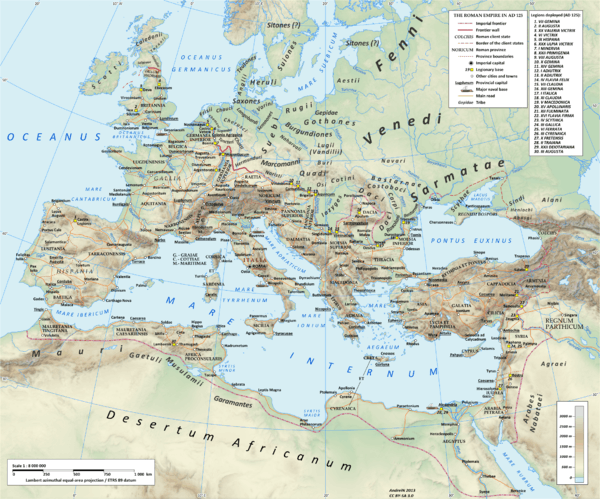Goths
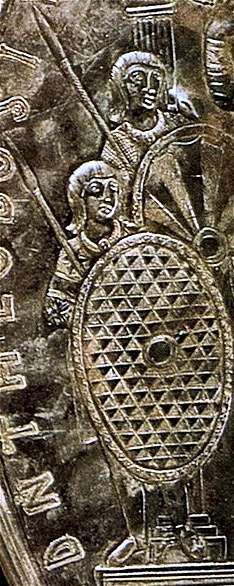
.jpg)
The Goths were an East Germanic people, two of whose branches, the Visigoths and the Ostrogoths, played an important role in the fall of the Western Roman Empire and the emergence of Medieval Europe. The Goths dominated a vast area,[1] which at its peak under the Germanic king Ermanaric and his sub-king Athanaric possibly extended all the way from the Danube to the Don, and from the Black Sea to the Baltic Sea.[2]
The Goths spoke the Gothic language, one of the Eastern Germanic languages; all are now extinct and left no modern descendants.
Etymology
In the Gothic language they were called the Gut-þiuda, most commonly translated as "Gothic people", but only attested as dat. sg. Gut-þiudai,[3] or Gutans Inferred from gen. pl.(?) gutani in Pietroassa inscription.[4] In Old Norse they were known as the Gutar or Gotar, in Latin as the Gothi, and in Greek as the Γότθοι, Gótthoi.
The Goths have been referred to by many names, perhaps at least in part because they comprised many separate ethnic groups, but also because in early accounts of Proto-Indo-European and later Germanic migrations in the Migration Period in general it was common practice to use various names to refer to the same group. The Goths believed (as most modern scholars do)[5] that the various names all derived from a single prehistoric ethnonym that referred originally to a uniform culture that flourished around the middle of the first millennium BC, i.e. the original Goths.
Origins
.png)
The exact origin of the ancient Goths is unknown. Evidence of them before they interacted with the Romans is limited.[6] The traditional account of the Goths' early history, based on the writings of the Ostrogoth Jordanes, a 6th-century Roman bureaucrat and historian, was that the earliest migrating Goths sailed from what is now Sweden to what is now Poland, and replaced inhabitants there, forming the Wielbark culture. Modern academics have generally abandoned this theory. Today, the Wielbark culture is thought to have developed from earlier cultures in the same area.[7] Archaeological finds show close contacts between southern Sweden and the Baltic coastal area on the continent, and further towards the south-east, evidenced by pottery, house types and graves. Rather than a massive migration, similarities in the material cultures may be products of long-term regular contacts. However, the archaeological record could indicate that while his work is thought to be unreliable,[8] Jordanes' story was based on an oral tradition with some basis in fact.[7]

red: Oksywie culture,
then early Wielbark culture
blue: Jastorf culture (light: expansion, purple: repressed)
yellow: Przeworsk culture (orange: repressed)
pink, orange, purple: expansion of Wielbark culture (2nd century AD)
Sometime around the 1st century AD, Germanic peoples may have migrated from Scandinavia to Gothiscandza, in present-day Poland. Early archaeological evidence in the traditional Swedish province of Östergötland suggests a general depopulation during this period.[9] However, there is no archaeological evidence for a substantial emigration from Scandinavia[10] and they may have originated in continental Europe.[11]
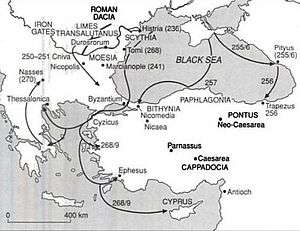
Upon their arrival on the Pontic Steppe, the Germanic tribes adopted the ways of the Eurasian nomads. The first Greek references to the Goths call them Scythians, since this area along the Black Sea historically had been occupied by an unrelated people of that name. The application of that designation to the Goths appears to be not ethnological but rather geographical and cultural, the latter in reference to the Greeks' considering both the ethnic Scythians and the Goths to be barbarians.[12]
The earliest known material culture associated with the Goths on the southern coast of the Baltic Sea is the Wielbark culture, centered on the modern region of Pomerania in northern Poland. This culture replaced the local Oxhöft or Oksywie culture in the 1st century, when a Scandinavian settlement was established in a buffer zone between the Oksywie culture and the Przeworsk culture.[13]
The culture of this area was influenced by southern Scandinavian culture beginning as early as the late Nordic Bronze Age and early Pre-Roman Iron Age (c. 1300 – c. 300 BC). In fact, the Scandinavian influence on Pomerania and today's northern Poland from c. 1300 BC (period III) and onwards was so considerable that some see the culture of the region as part of the Nordic Bronze Age culture.[14] In Eastern Europe they formed part of the Chernyakhov culture.
Migrations and contact with Rome
Around 160 AD, in Central Europe, the first movements of the Migration Period were occurring, as Germanic tribes began moving south-east from their ancestral lands at the mouth of River Vistula, putting pressure on the Germanic tribes from the north and east. As a result, in episodes of Gothic and Vandal warfare Germanic tribes (Rugii, Goths, Gepids, Vandals, Burgundians, and others)[15] crossed either the lower Danube or the Black Sea, and led to the Marcomannic Wars,[16] which resulted in widespread destruction and the first invasion of what is now Italy in the Roman Empire period.[17] It has been suggested that the Goths maintained contact with southern Sweden during their migration.[18]
In the first attested incursion in Thrace, the Goths were mentioned as Boranoi by Zosimus, and then as Boradoi by Gregory Thaumaturgus.[12] The first incursion of the Roman Empire that can be attributed to Goths is the sack of Histria in 238. Several such raids followed in subsequent decades,[12] in particular the Battle of Abrittus in 251, led by Cniva, in which the Roman Emperor Decius was killed. At the time, there were at least two groups of Goths: the Thervingi and the Greuthungs. Goths were subsequently heavily recruited into the Roman Army to fight in the Roman-Persian Wars, notably participating at the Battle of Misiche in 242. The Moesogoths settled in Thrace and Moesia.[19]
The first seaborne raids took place in three subsequent years, probably 255-257. An unsuccessful attack on Pityus was followed in the second year by another, which sacked by Pityus and Trabzon and ravaged large areas in the Pontus. In the third year, a much larger force devastated large areas of Bithynia and the Propontis, including the cities of Chalcedon, Nicomedia, Nicaea, Apamea Myrlea, Cius and Bursa. By the end of the raids, the Goths had seized control over Crimea and the Bosphorus and captured several cities on the Euxine coast, including Olbia and Tyras, which enabled them to engage in widespread naval activities.[20]
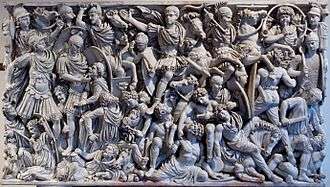
After Gallienus was assassinated outside Milan in the summer of 268 in a plot led by high officers in his army, Claudius Gothicus was proclaimed emperor and headed to Rome to establish his rule. Claudius' immediate concerns were with the Alamanni, who had invaded Raetia and Italy. After he defeated them in the Battle of Lake Benacus, he was finally able to take care of the invasions in the Balkan provinces.[21]
Learning of the approach of Claudius, the Goths first attempted to directly invade Italy.[22] They were engaged at the Battle of Naissus.
It seems that Aurelian, who was in charge of all Roman cavalry during Claudius' reign, led the decisive attack in the battle. Some survivors were resettled within the empire, while others were incorporated into the Roman army. The battle ensured the survival of the Roman Empire for another two centuries. In 270, after the death of Claudius, Goths under the leadership of Cannabaudes again launched an invasion on the Roman Empire, but were defeated by Aurelian, who however surrendered Dacia beyond the Danube.
Around 275 the Goths launched a last major assault on Asia Minor, where piracy by Black Sea Goths was causing great trouble in Colchis, Pontus, Cappadocia, Galatia and even Cilicia.[23] They were defeated sometime in 276 by Emperor Marcus Claudius Tacitus.[23]
In 332, Constantine helped the Sarmatians to settle on the north banks of the Danube to defend against the Goths' attacks and thereby enforce the Roman Empire's border. Around 100,000 Goths were reportedly killed in battle, and Ariaricus, son of the King of the Goths, was captured.
As the Goths increasingly became soldiers in the Roman armies in the 4th Century AD, contributing to the almost complete Germanization of the Roman Army by that time.[15] The Gothic penchant for wearing skins became fashion in Constantinople, which was heavily denounced by conservatives.[24]
Following a famine the Gothic War of 376–382 ensued, where the Goths and some of the local Thracians rebelled. The Roman Emperor Valens was killed at the Battle of Adrianople in 378. Following the decisive Gothic victory at Adrianople, Julius, the magister militum Eastern Roman Empire,[12] organized a widescale massacre of Goths in Asia Minor, Syria and other parts of the Roman East.[12] Fearing rebellion, Julian lured the Goths into the confines of urban streets from which they could not escape and massacred soldiers and civilians alike.[12] As word spread among the Goths rioted throughout the region, and large numbers were killed.[12] Survivors may have settled in Phrygia.[12] Although the Huns successfully subdued many of the Goths, who joined their ranks, a group of Goths led by Fritigern fled across the Danube. Major sources for this period of Gothic history include Ammianus' Res gestae, which mentions Gothic involvement in the civil war between emperors Procopius and Valens of 365 and recounts the Gothic War (376-382). Around 375 AD the Huns overran the Alans and then the Goths.
In the late fourth century: the Huns arrived from the east and invaded the region controlled by the Goths.
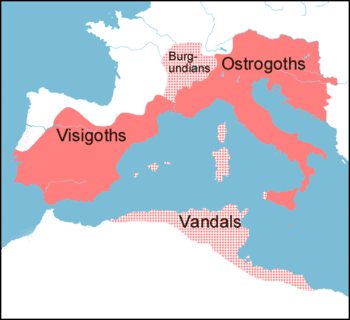
Visigoths and Ostrogoths
By the 4th century, the Goths had captured Roman Dacia[25] and divided into at least two distinct groups separated by the Dniester River: the Thervingi (led by the Balti dynasty) and the Greuthungi (led by the Amali dynasty). The Goths separated into two main branches, the Visigoths, who became foederati (federates) of the Roman Empire, and the Ostrogoths, who joined the Huns.
Both the Greuthungi and Thervingi became heavily Romanized during the 4th Century. This came about through trade with the Romans, as well as through Gothic membership of a military covenant, which was based in Byzantium and involved pledges of military assistance. Reportedly, 40,000 Goths were brought by Constantine to defend Constantinople in his later reign, and the Palace Guard was mostly composed of Germanic soldiers, as the quality and quantity of the native Romans troops kept declining.[26] The Gothic missionary Wulfila devised the Gothic alphabet to translate the Wulfila Bible, had converted many of the Goths from Germanic paganism to Arian Christianity.
The Goths remained divided – as Visigoths and Ostrogoths – during the 5th Century. These two tribes were among the Germanic peoples who clashed with the late Roman Empire during the Migration Period. A Visigothic force led by Alaric I sacked Rome in 410. Honorius granted the Visigoths Aquitania, where they defeated the Vandals and conquered most of the Iberian Peninsula by 475.
Visigoths
The Huns fell upon the Thervingi, whose staunchly pagan ruler, Athanaric, sought refuge in the mountains. Meanwhile, the Arian Thervingian rebel chieftain Fritigern approached the Eastern Roman Emperor Valens in 376 with a portion of his people and asked to be allowed to settle with his people on the south bank of the Danube. Valens permitted this, and even assisted the Goths in their crossing of the river[27] (probably at the fortress of Durostorum).
In 410, the Visigoths' Sack of Rome (410) under Alaric I, defeated Attila at the Battle of the Catalaunian Plains under Theodoric I in 451, and founded in 418 a Visigothic Kingdom in Aquitaine.
In 507, the Visigoths were pushed into Hispania by the Frankish Kingdom following the Battle of Vouillé in 507. By the late 6th century, the Visigoths had converted to Christianity. They were conquered in 711 when the Muslim Moors defeated Roderic during the Umayyad conquest of Hispania, but they founded the Kingdom of Asturias in 718 and began to regain control under the leadership of the Visigothic nobleman Pelagius of Asturias, whose victory at the Battle of Covadonga (ca. 722) began the centuries-long Reconquista. It was from the Asturian kingdom that modern Spain and Portugal evolved.[28] These Goths became completely Hispanicized, retaining little of their original culture except for Germanic names still in use in present-day Spain.
In the late 6th Century Goths settled as foederati in parts of Asia Minor. Their descendants, who formed the elite Optimatoi regiment, still lived there in the early 8th Century. While they were largely assimilated, their Gothic origin was still well-known: The chronicler Theophanes the Confessor calls them Gothograeci.
Ostrogoths
Christopher I. Beckwith suggests that the entire Hunnic thrust into Europe and the Roman Empire was an attempt to subdue independent Goths in the west.[29] It is possible that the Hunnic attack came as a response to the Gothic eastwards expansion.[29][30][31] Ermanaric committed suicide, and the Greuthungi fell under Hunnic dominance.
In the 4th Century, the Greuthungian king Ermanaric became the most powerful Gothic ruler, coming to dominate a vast area of the Pontic Steppe which possibly stretched from the Baltic Sea to the Black Sea as far eastwards as the Ural Mountains.[32] Ermanaric's dominance of the Volga-Don trade routes made historian Gottfried Schramm consider his realm as a forerunner of the Viking founded state of Kievan Rus'.[33]
In 454 AD, the Ostrogoths successfully revolted against the Huns at the Battle of Nedao and their leader Theoderic the Great invaded what is now Italy in 488 and settled his people there, founding an Ostrogothic Kingdom which eventually gained control of the whole Italian peninsula.
Under Theodemir, the Ostrogoths broke away from Hunnic rule following the Battle of Nedao in 454, and decisively defeated the Huns again under Valamir at Bassianae in 468. At the request of emperor Zeno, Theodoric the Great conquered all of Italy from the Scirian Odoacer beginning in 488. The Goths were briefly reunited under one crown in the early 6th century under Theodoric the Great, who became regent of the Visigothic kingdom following the death of Alaric II at the Battle of Vouillé in 507. Procopius interpreted the name Visigoth as "western Goths" and the name Ostrogoth as "eastern Goth", reflecting the geographic distribution of the Gothic realms at that time.
The Ostrogothic kingdom persisted until 553 under Teia, when Italy returned briefly to Byzantine control. This restoration of imperial rule was reversed by the conquest of the Lombards in 568. Shortly after Theodoric's death, the country was conquered by the Byzantine Empire in the Gothic War (535–554) that devastated and depopulated the peninsula.[34] In 552, after their leader Totila was killed at the Battle of Taginae (552), effective Ostrogothic resistance ended, and the remaining Goths in Italy were assimilated by the Lombards, another Germanic tribe, who invaded Italy and founded the Kingdom of the Lombards in 567 AD.
In the late 18th century, Gothic tribes who remained in the lands around the Black Sea, especially in Crimea - then known as Crimean Goths - were still mentioned as existing in the region and speaking a Crimean Gothic dialect, making them the last true Goths. The language is believed to have been spoken until as late as 1945. They are believed to have been assimilated by the Crimean Tartars. However, it was claimed that the Crimean Goths had survived to interbreed with German settlers in Crimea during the Third Reich and that German communities in Crimea constituted native peoples of that area.
Culture
Art
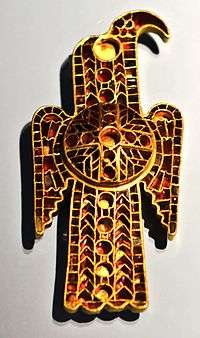
Before the invasion of the Huns, the Gothic Chernyakhov culture produced jewelry, vessels, and decorative objects in a style much influenced by Greek and Roman craftsmen. They developed a polychrome style of gold work, using wrought cells or setting to encrust gemstones into their gold objects. This style was influential in West Germanic areas well into the Middle Ages.
Language
The Gothic language is an extinct language, a branch of the Germanic languages that was spoken by the Goths. It is known primarily from the Codex Argenteus, a 6th Century copy of a 4th Century Bible translation, and is the only one of the East Germanic languages with a sizable corpus. All others, including Burgundian and Vandalic, are known, if at all, only from proper names that survived in historical accounts, and from loan-words in other languages like Spanish and French.
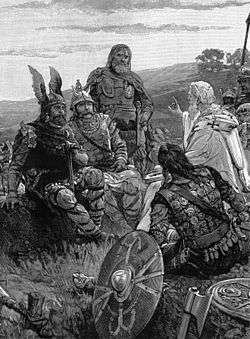
Gothic is the Germanic language with the earliest attestation. The oldest documents in Gothic date to the 4th century. The existence of such early-attested documents in Gothic makes it a language of considerable interest in comparative linguistics. The language was in decline by the mid-6th century, due in part to the military defeat of the Goths at the hands of the Franks, the elimination of the Goths in Italy, and geographic isolation (in Spain the Gothic language lost its last and probably already declining function as a church language when the Visigoths converted to Catholicism in 589).[35]
Society
Archaeological evidence in Visigothic cemeteries shows that social stratification was analogous to that of the village of Sabbas the Goth. The majority of villagers were common peasants. Paupers were buried with funeral rites, unlike slaves. In a village of 50 to 100 people, there were four or five elite couples.[36]
In Eastern Europe, houses include sunken-floored dwellings, surface dwellings, and stall-houses. The largest known settlement is the Criuleni District.[37] Chernyakhov cemeteries feature both cremation and inhumation burials; among the latter the head is to the north. Some graves were left empty. Grave goods often include pottery, bone combs, and iron tools, but hardly ever weapons.[38]
Economy
Archaeology shows that the Visigoths, unlike the Ostrogoths, were predominantly farmers. They sowed wheat, barley, rye, flax. They also raised pigs, poultry, and goats. Horses and donkeys were raised as working animals, and fed with hay. Sheep were raised for their wool, which they fashioned into clothing Archaeology indicates they were skilled potters and blacksmiths. When peace treaties were negotiated with the Romans, the Goths demanded free trade. Imports from Rome included wine, and cooking-oil.[39]
Religion
Initially practising Gothic paganism, the Goths were gradually converted to Arian Christianity in the course of the 4th Century as a result of the missionary activity by the Gothic bishop Wulfila, who devised a Gothic alphabet to translate the Wulfila Bible.
During the 370s, converted Goths were subject to the Gothic persecution of Christians by the remaining pagan authorities of the Thervingi people.
The Visigothic Kingdom in Hispania converted to Catholicism in the 7th Century.
The Ostrogoths (and their remnants, the Crimean Goths) were closely connected to the Patriarchate of Constantinople from the 5th Century, and became fully incorporated under the Metropolitanate of Gothia from the 9th Century.
Legacy
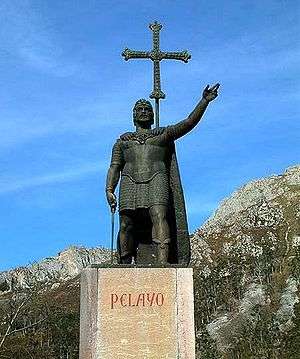
The Gotlanders themselves had oral traditions of a mass migration towards southern Europe, recorded in the Gutasaga. If the facts are related, this would be a unique case of a tradition that endured for more than a thousand years and that actually pre-dates most of the major splits in the Germanic language family.
The Goths' relationship with Sweden became an important part of Swedish nationalism, and, until the 19th Century, the Swedes were commonly considered to be the direct descendants of the Goths. Today, Swedish scholars identify this as a cultural movement called Gothicismus, which included an enthusiasm for things Old Norse.
Gothic language and culture largely disappeared during the Middle Ages, although its influence continued in small ways in some western European states. As late as the 16th century a small number of people in the Crimea may still have spoken Crimean Gothic.[40]
The language survived as a domestic language in the Iberian peninsula (modern Spain and Portugal) as late as the 8th Century, and Frankish author Walafrid Strabo wrote that it was still spoken in the lower Danube area and in that Crimean Gothic was spoken in isolated mountain regions in Crimea in the early 9th century. Gothic-seeming terms found in later (post-9th century) manuscripts may not belong to the same language.
In Medieval and Modern Spain, the Visigoths were believed to be the origin of the Spanish nobility (compare Gobineau for a similar French idea). By the early 7th Century, the ethnic distinction between Visigoths and Hispano-Romans had all but disappeared, but recognition of a Gothic origin, e.g. on gravestones, still survived among the nobility. The 7th Century Visigothic aristocracy saw itself as bearers of a particular Gothic consciousness and as guardians of old traditions such as Germanic namegiving; probably these traditions were on the whole restricted to the family sphere (Hispano-Roman nobles did service for Visigothic nobles already in the 5th century and the two branches of Spanish aristocracy had fully adopted similar customs two centuries later).[41]
In Chile, Argentina and the Canary Islands, godo was an ethnic slur used against European Spaniards, who in the early colony period often felt superior to the people born locally (criollos). In Colombia the members of the Colombian Conservative Party were referred to as godos.
The Spanish and Swedish claims of Gothic origins led to a clash at the Council of Basel in 1434. Before the assembled cardinals and delegations could engage in theological discussion, they had to decide how to sit during the proceedings. The delegations from the more prominent nations argued that they should sit closest to the Pope, and there were also disputes over who was to have the finest chairs and who was to have their chairs on mats. In some cases, they compromised so that some would have half a chair leg on the rim of a mat. In this conflict, Nicolaus Ragvaldi, bishop of the Diocese of Växjö, claimed that the Swedes were the descendants of the great Goths, and that the people of Västergötland (Westrogothia in Latin) were the Visigoths and the people of Östergötland (Ostrogothia in Latin) were the Ostrogoths. The Spanish delegation retorted that it was only the lazy and unenterprising Goths who had remained in Sweden, whereas the heroic Goths had left Sweden, invaded the Roman empire and settled in Spain.[42]
Gutnish is still spoken in Gotland and Fårö. Old Gutnish was the dialect of Old Norse there.
The Goths in the sagas
- According to Hervarar saga ok Heiðreks (The Saga of Hervör and Heidrek), a 13th-century legendary saga, Árheimar was a capital of the Goths. The saga states that it was located on the River Dnieper.
- Hlöðskviða (The Battle of the Goths and Huns)
Ancients who wrote about the Goths
- Ambrose: The prologue of De Spiritu Sancto (On the Holy Ghost) makes passing reference to Athanaric's royal titles before 376.[43] Comment on Saint Luke: "Chuni in Halanos, Halani in Gothos, Gothi in Taifalos et Sarmatas insurexerunt"
- Ammianus Marcellinus: Res Gestae Libri XXXI.[44] He wrote that Hunnic domination of the Gothic kingdoms in Scythia began in the 370s.[45]
- The anonymous author(s) of the Augustan History wrote that the Goths, along with the Heruli sacked Heraclea Pontica, Cyzicus and Byzantium. They were defeated by the Roman navy but managed to escape into the Aegean Sea, where they ravaged the islands of Lemnos and Scyros. In the Battle of Thermopylae (267) they sacked several cities of southern Greece (province of Achaea) including Athens, Corinth, Argos, Olympia and Sparta. An Athenian militia, led by the historian Dexippus, pushed the invaders to the north where they were intercepted by the Roman army under Gallienus.[46] However, large portions are known to be fraudulent and the factual accuracy of the remainder is disputed.[47] Of the second invasions, the history reports that an enormous coalition consisting of Goths (Greuthungi and Thervingi), Gepids and Bastarnae, led again by the Heruli, assembled at the mouth of river Tyras (Dniester).[48] They claim a total number of 2,000–6,000 ships and 325,000 men.[49] This is probably a gross exaggeration but remains indicative of the scale of the invasion. After failing to storm some towns on the coasts of the western Black Sea and the Danube (Constanţa, Marcianopolis), they attacked Byzantium and Uskudar. Part of their fleet was wrecked, either because of the Gothic inexperience in sailing through the violent currents of the Propontis[50] or because it was defeated by the Roman navy.
- Aurelius Victor: The Caesars, a history from Augustus to Constantius II
- Cassiodorus: A lost history of the Goths used by Jordanes
- Claudian: Poems
- Epitome de Caesaribus
- The 4th Century Greek historian Eunapius described the Goths' powerful build in a pejorative way: Their bodies provoked contempt in all who saw them, for they were far too big and far too heavy for their feet to carry them, and they were pinched in at the waist – just like those insects Aristotle writes of.[51] Eutropius: Breviary
- Eusebius, an historian who wrote in Greek in the third century, wrote that in 334, Constantine evacuated approximately 300,000 Sarmatians from the north bank of the Danube after a revolt of the Sarmatians' slaves. From 335 to 336, Constantine, continuing his Danube campaign, defeated many Gothic tribes.[52]
- Gregory of Nyssa
- Hermann of Reichenau, an 11th-century scholar, wrote that the Goths entered the Aegean Sea and a detachment ravaged the Aegean islands as far as Crete, Rhodes and Cyprus. The fleet probably also sacked Troy and Ephesus, destroying the Temple of Artemis, one of the Seven Wonders of the Ancient World. While their main force had constructed siege works and was close to taking the cities of Thessalonica and Cassandreia, it retreated to the Balkan interior at the news that the emperor was advancing. On their way, they plundered Dojran and Pelagonia.[53]
- Jerome: Chronicle
- Jordanes, in his Getica, written in the mid-500s, wrote that the earliest migrating Goths sailed from Scandza (Scandinavia) under King Berig in three ships. One shipload settled near the Vistula.[54] They then moved into an area along the southern coast of the Baltic Sea which was inhabited by the Rugians, and expelled them.[55]
- Julian the Apostate
- Lactantius: On the death of the Persecutors
- Olympiodorus of Thebes
- Panegyrici latini
- Paulinus the Deacon: Life of bishop Ambrose of Milan
- Paulus Orosius wrote that the Goths were of the same stock as the Suiones (Swedes), the Vandals, and the other Scandinavian tribes.[56]
- Philostorgius: Greek church history
- Pliny the Elder wrote that Pytheas, an explorer who visited Northern Europe in the 4th century BC., reported that the Gutones, a people of Germany, inhabit the shores of an estuary called Mentonomon (the Baltic Sea).[57]
- The 6th Century Byzantine historian Procopius wrote that the Goths were tall and blond haired: For they all have white bodies and fair hair, and are tall and handsome to look upon.[58]
- He noted that the Goths, Gepidae and Vandals were physically and culturally identical, suggesting a common origin.[58]
- Sozomen
- Synesius: De regno and De providentia. The 4th Century Greek bishop compared the Goths to wolves among sheep, mocked them for wearing skins and questioned their loyalty towards Rome:
A man in skins leading warriors who wear the chlamys, exchanging his sheepskins for the toga to debate with Roman magistrates and perhaps even sit next to a Roman consul, while law-abiding men sit behind. Then these same men, once they have gone a little way from the senate house, put on their sheepskins again, and when they have rejoined their fellows they mock the toga, saying that they cannot comfortably draw their swords in it.[24]
- Tacitus wrote that the Goths and the neighboring Rugii and Lemovii carried round shields and short swords.[59] However, the Goths who would later fight or be allied with the Huns, and who fought for and against Rome, might not be the same people Tacitus describes.[60]
- Themistius: Speeches
- Theoderet of Cyrrhus
- Theodosian Code
- According to Zosimus, Dexippus won an important victory near the Nessos (Mesta River), on the boundary between the Roman province of Macedonia and Thrace, the Dalmatian cavalry of the Roman army earning a reputation as good fighters. Reported barbarian casualties were 3,000 men. He writes about the Battle of Naissus by a Roman army led by Claudius advancing from the north. The battle most likely took place in 269, and was fiercely contested. Large numbers on both sides were killed but, at the critical point, the Romans tricked the Goths into an ambush by pretended flight. Around 50,000 Goths were allegedly killed or taken captive and their base at Thessalonika destroyed.[61]
References
- ↑ "Ostrogoth". Encyclopædia Britannica Online. Encyclopædia Britannica, Inc. Retrieved January 16, 2015.
- ↑ Waldman, Carl; Mason, Catherine (2006). Encyclopedia of European peoples. New York: Facts On File. p. 575. ISBN 978-0816049646.
- ↑ Hewitt, Winfred P. Lehmann ; with bibliography prepared under the direction of Helen-Jo J. (1986). A Gothic etymological dictionary. Leiden: E.J. Brill. pp. 163–164. ISBN 978-9004081765.
- ↑ Braune, W; Heidermanns, F (2004). Gotische Grammatik. Tübingen: Niemeyer.
- ↑ Dunlap, Herwig Wolfram ; translated by Thomas J. (1990). History of the Goths (New and completely rev. from the 2nd German ed., 1st pbk. print. ed.). Berkeley: University of California Press. pp. 16–56, 209–210. ISBN 978-0520069831.
- ↑ "Who Were the Ancient Goths?". Retrieved 2016-09-09.
- 1 2 Kaliff, Anders (2001). Gothic Connections. Contacts between eastern Scandinavia and the southern Baltic coast 1000 BC – 500 AD. Uppssala: OPIA. Retrieved 7 September 2016.
- ↑ Kessler, P L. "Kingdoms of the Germanic Tribes - Goths / Ostrogoths". www.historyfiles.co.uk. Retrieved 2016-09-09.
- ↑ Oxenstierna, Eric (1945). Die Urheimat der Goten. Johann Ambrosius Barth. p. 73.
- ↑ Heather, Peter (1998). The Goths (Pbk. ed. ed.). Oxford, UK: Blackwell Publishers. p. 26. ISBN 978-0631209324.
- ↑
- The origin of the Goths (PDF), Neðerlands: Kortland
- 1 2 3 4 5 6 7 8 Kulikowski, Michael (2008-05-01). Rome's Gothic Wars: From the Third Century to Alaric (1 edition ed.). Cambridge University Press. ISBN 9780521608688.
- ↑ Kokowski, Andrzej (1999), Archäologie der Goten (in German), ISBN 83-907341-8-4.
- ↑ Dabrowski, J. (1989). Nordische Kreis un Kulturen Polnischer Gebiete. Die Bronzezeit im Ostseegebiet. p. 73.
- 1 2 "History of Europe: The Germans and Huns". Encyclopædia Britannica Online. Encyclopædia Britannica, Inc. Retrieved January 16, 2015.
- ↑ Gibbon, Edward (1930). The Decline and Fall of the Roman Empire. Plain Label Books. ISBN 978-1-60303-405-0.
- ↑ "Germany: Ancient History". Encyclopædia Britannica Online. Encyclopædia Britannica, Inc. Retrieved January 16, 2015.
- ↑ Arhenius, B, Connections between Scandinavia and the East Roman Empire in the Migration Period, pp. 119, 134, in Alcock, Leslie (1990), From the Baltic to the Black Sea: Studies in Medieval Archaeology, London: Unwin Hyman, pp. 118–37.
- ↑
 "Goth". Collier's New Encyclopedia. 1921.
"Goth". Collier's New Encyclopedia. 1921. - ↑ Bowman, Garnsey & Cameron 2005, pp. 223–229
- ↑ John Bray, p.290
- ↑ Tucker 2009, p. 150
- 1 2 Bowman, Garnsey & Cameron 2005, pp. 53–54
- 1 2 Cameron, Long & Sherry 1993, p. 99
- ↑ "Goth". Encyclopædia Britannica Online. Encyclopædia Britannica, Inc. Retrieved January 16, 2015.
- ↑ "Ancient Rome: The Reign of Constantine". Encyclopædia Britannica Online. Encyclopædia Britannica, Inc. Retrieved 16 January 2015.
- ↑ Kulikowski 2006, p. 130.
- ↑ "Spain: The Christian states, 711–1035". Encyclopædia Britannica Online. Encyclopædia Britannica, Inc. Retrieved January 16, 2015.
- 1 2 Beckwith 2009, pp. 331–332
- ↑ Beckwith 2009, pp. 81–83
- ↑ Beckwith 2009, pp. 94–100
- ↑ Wolfram 1997, pp. 26–28
- ↑ Gottfried Schramm, Altrusslands Anfang. Historische Schlüsse aus Namen, Wörtern und Texten zum 9. und 10. Jahrhundert, Freiburg i. Br. 2002, p. 54.
- ↑ London, Jack (2007). The Human Drift. 1st World Publishing. p. 11. ISBN 978-1-4218-3371-2.
- ↑ Pohl, Walter. Strategies of Distinction: Construction of Ethnic Communities, 300–800 (Transformation of the Roman World. pp. 119–21. ISBN 90-04-10846-7..
- ↑ "Visigothic Society". Magyar Elektonikus Könyvtár.
- ↑ Heather, Peter; Matthews, John (1991). The Goths in the fourth century (Repr. ed.). Liverpool: Liverpool Univ. Press. ISBN 978-0853234265.
- ↑ The Goths in the Fourth Century (1 edition ed.). Liverpool University Press. 1991-01-10. ISBN 9780853234265.
- ↑ "The Visigoths' Peasant Economy". Magyar Elektronikus Könyvtár. Retrieved 17 September 2016.
- ↑ Bennett, William H (1980). An Introduction to the Gothic Language. p. 27.
- ↑ Pohl, Walter. Strategies of Distinction: Construction of Ethnic Communities, 300–800 (Transformation of the Roman World). pp. 124–6. ISBN 90-04-10846-7..
- ↑ Söderberg, Werner. (1896). "Nicolaus Ragvaldis tal i Basel 1434", in Samlaren, pp. 187–95.
- ↑ Ambrose, On the Holy Ghost, book I, preface, paragraph 15
- ↑ Edward Gibbon judged Ammianus "an accurate and faithful guide, who composed the history of his own times without indulging the prejudices and passions which usually affect the mind of a contemporary." (Gibbon, Edward, Decline and Fall of the Roman Empire, Chapter 26.5). But he also condemned Ammianus for lack of literary flair: "The coarse and undistinguishing pencil of Ammianus has delineated his bloody figures with tedious and disgusting accuracy." (Gibbon, Chapter 25.) Ernst Stein praised Ammianus as "the greatest literary genius that the world produced between Tacitus and Dante" (E. Stein, Geschichte des spätrömischen Reiches, Vienna 1928).
- ↑ "However, the seed and origin of all the ruin and various disasters that the wrath of Mars aroused ... we have found to be (the invasions of the Huns)",Marcellinus, Ammianus; tr. John Rolfe (1922), "2", Latin text and English translation, XXXI, Loeb edition.
- ↑ Scriptores Historiae Augustae, Vita Gallienii, 13.8
- ↑ Craig H. Caldwell: Contesting late Roman Illyricum. Invasions and transformations in the Danubian-Balkan provinces. A dissertation presented to the Pricenton University in candidacy for the degree of doctor in philosophy. Quote: "The Life Of Probus like much of the rest of Historia Augusta is a more trustworthy source for its fourth-century audience then for its third-century subject"; Robert J. Edgeworthl (1992): More Fiction in the "Epitome". Steiner. Quote: "For a century it has been established to general if not universal satisfaction, that biographies in Historia Augusta, especially after Caracalla, are a tissue of fiction and fabrication layered onto a thin thread of historical fact"; this view originates with Hermann Dessau.
- ↑ The Historia Augusta mentions Scythians, Greuthungi, Tervingi, Gepids, Peucini, Celts and Heruli. Zosimus names Scythians, Heruli, Peucini and Goths.
- ↑ Scriptores Historiae Augustae, Vita Divi Claudii, 6.4
- ↑ Zosimus, 1.42
- ↑ Moorhead & Stuttard 2010, p. 56
- ↑ Eusebius, "IV.6", Vita Constantini
- ↑ Contractus, Hermannus, Chronicon, quoting of Caesarea, Eusebius, Vita Constantini, p. 263: "Macedonia, Graecia, Pontus, Asia et aliae provinciae depopulantur per Gothos".
- ↑ Jordanes; Charles C. Mierow, Translator (1997). "The Origins and Deeds of the Goths". Calgary: J. Vanderspoel, Department of Greek, Latin and Ancient History, University of Calgary. pp. 24–96. Retrieved October 26, 2013.
- ↑ Beck, Heinrich; Geuenich, Dieter; Hoops, Johannes; Jankuhn, Herbert; Steuer, Heiko (2004), Reallexikon der Germanischen Altertumskunde (in German) (2nd ed.), Berlin: Walter de Gruyter, pp. 452ff, ISBN 978-3-11-017733-6.
- ↑ Orosius (417). The Anglo-Saxon Version, from the Historian Orosius (Alfred the Great ed.). London: Printed by W. Bowyer and J. Nichols and sold by S. Baker. Retrieved 28 March 2016.
- ↑ Bostock, John. "Pliny the Elder, The Natural History".
- 1 2 Procopius. History of the Wars. Book III. II
- ↑ Tacitus, Cornelius (2008-11-14). The Works of Tacitus: The Oxford Translation, Revised, with Notes, Volume II. BiblioLife. ISBN 9780559473357.
- ↑ "The Goths". Retrieved 2016-09-09.
- ↑ Zosimus, 1.43
Sources
- Andersson, Thorsten (1996). "Göter, goter, gutar". Namn och Bygd (in Swedish). Uppsala. 84: 5–21.
- Beckwith, Christopher I. (16 March 2009). Empires of the Silk Road: A History of Central Eurasia from the Bronze Age to the Present. Princeton University Press. ISBN 1400829941. Retrieved 30 December 2014.
- Bell-Fialkoff, Andrew, Editor (2000). The Role of Migration in the History of the Eurasian Steppe: Sedentary Civilization vs. "Barbarian" and Nomad. New York: St. Martin's Press. ISBN 0-312-21207-0.
- Bowman, Alan; Garnsey, Peter; Cameron, Averil (September 8, 2005). The Cambridge Ancient History: Volume 12, The Crisis of Empire, AD 193-337. Cambridge University Press. ISBN 0521301998. Retrieved January 17, 2015.
- Bradley, Henry (1888). The Goths: From the Earliest Times to the End of the Gothic Dominion in Spain. London: T. Fisher Unwin. ISBN 1-4179-7084-7. Downloadable Google Books.
- Cameron, Alan; Long, Jacqueline; Sherry, Lee (20 June 2013). Barbarians and Politics at the Court of Arcadius. University of California Press. ISBN 0520065506. Retrieved January 17, 2015.
- Hermodsson, Lars: Goterna — ett krigafolk och dess bibel, Stockholm, Atlantis, 1993.
- Jacobsen, Torsten Cumberland, The Gothic War: Rome's Final Conflict in the West. Yardley: Westholme, 2009. x, 371 p.
- Jūratė Statkutė de Rosales Balts and Goths : the missing link in European history, translation by Danutė Rosales ; supervised and corrected by Ed Tarvyd. Lemont, Ill. : Vydūnas Youth Fund, 2004.
- Kulokowski, Michael (October 30, 2006). Rome's Gothic Wars: From the Third Century to Alaric. Cambridge University Press. ISBN 1139458094. Retrieved January 17, 2015.
- Mastrelli, Carlo Alberto in Volker Bierbauer et al., I Goti, Milan: Electa Lombardia, Elemond Editori Associati, 1994.
- Moorhead, Sam; Stuttard, David (2010). AD410: The Year that Shook Rome. Getty Publications. ISBN 1606060244. Retrieved January 17, 2015.
- Nordgren, I.: Goterkällan — om goterna i Norden och på kontinenten, Skara: Vaestergoetlands museums skriftserie nr 30, 2000.
- Nordgren, I.: The Well Spring of the Goths: About the Gothic peoples in the Nordic Countries and on the Continent (2004).
- Rodin, L.; Lindblom, V; Klang, K.: Gudaträd och västgötska skottkungar – Sveriges bysantiska arv, Göteborg: Tre böcker, 1994.
- Schaetze der Ostgoten, Stuttgart: Theiss, 1995. Studia Gotica — Die eisenzeitlichen Verbindungen zwischen Schweden und Suedosteuropa — Vortraege beim Gotensymposion im Statens Historiska Museum, Stockholm 1970.
- Wenskus, Reinhard: Stammesbildung und Verfassung. Das Werden der Frühmittelalterlichen Gentes (Köln 1961).
- Tucker, Spencer (December 23, 2009). A Global Chronology of Conflict: From the Ancient World to the Modern Middle East. ABC-CLIO. ISBN 1851096728. Retrieved January 17, 2015.
- Wolfram, Herwig (1997). The Roman Empire and Its Germanic Peoples. University of California Press. ISBN 0520085116. Retrieved 1 January 2015.
| Wikimedia Commons has media related to Goths. |
| Wikisource has the text of the 1911 Encyclopædia Britannica article Goths. |

